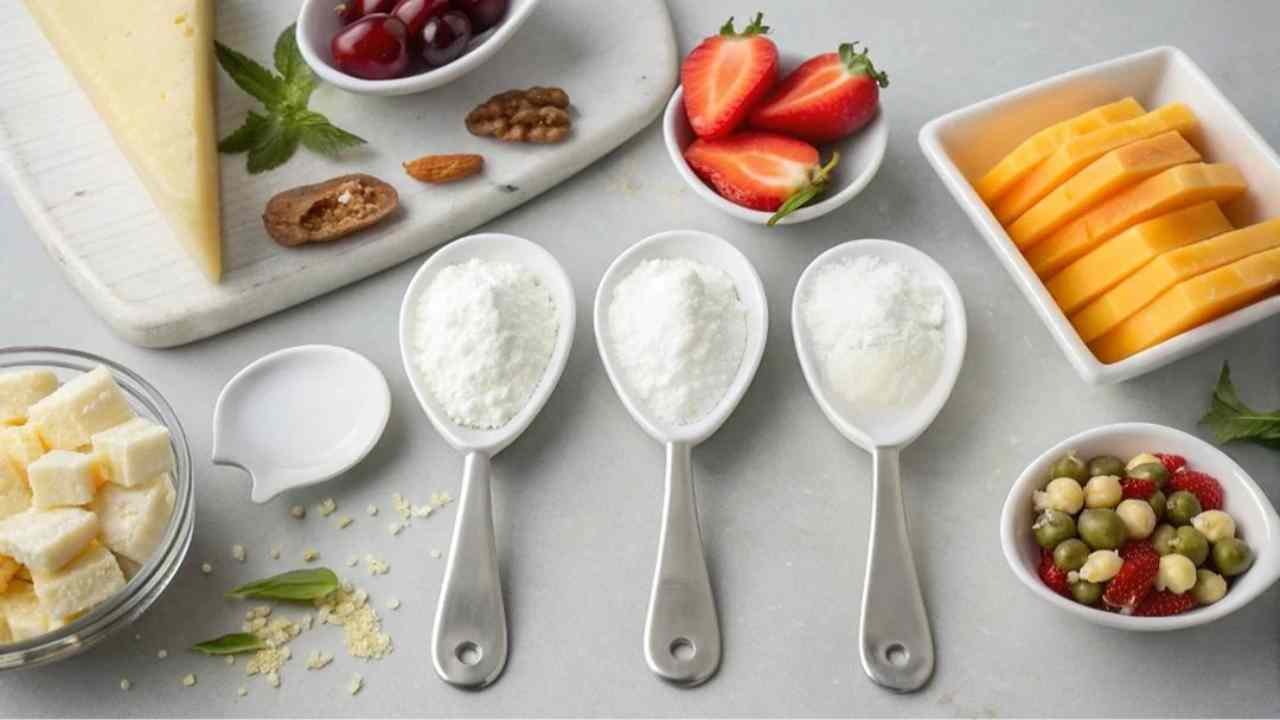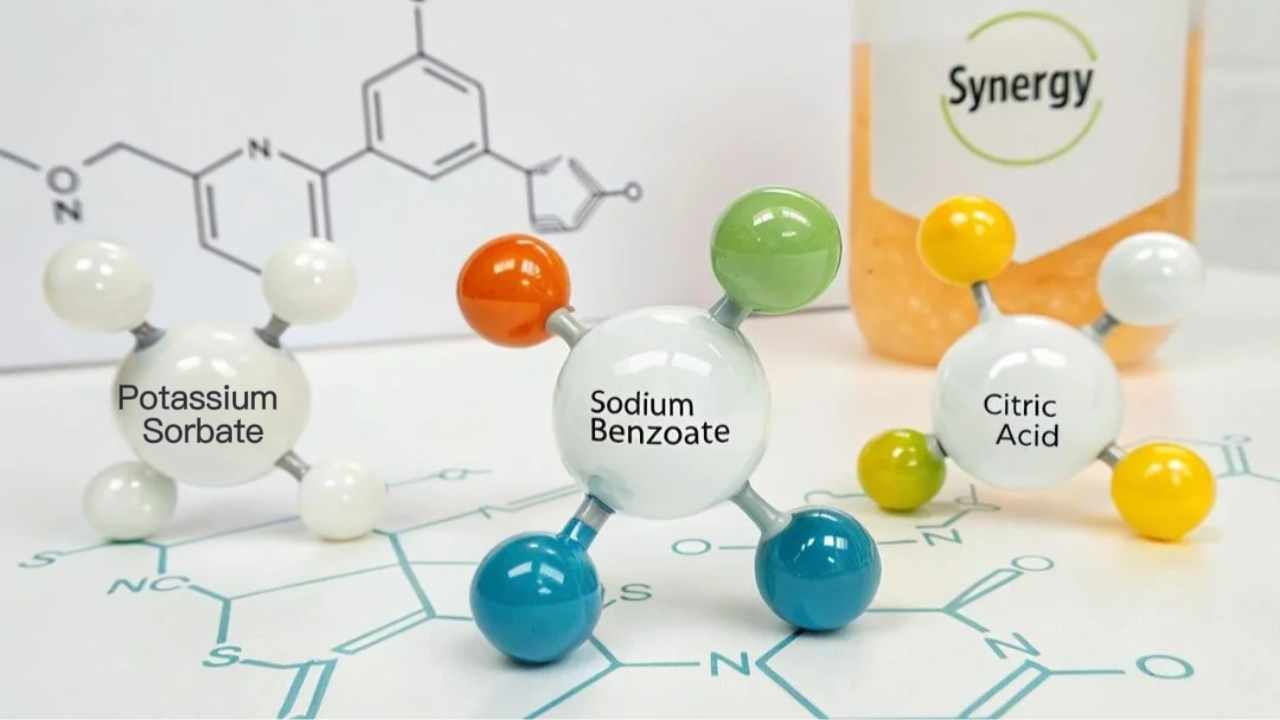Want longer-lasting, safer food products? Wondering how potassium sorbate helps achieve this? Let's explore how this preservative protects quality and extends shelf life.
Potassium sorbate ensures product quality by effectively inhibiting molds and yeasts, the main spoilage culprits. This action extends shelf life, maintaining freshness and safety, especially in acidic foods.
Quality and shelf life are vital. At FINETECH, clients need ingredients that prevent spoilage. Potassium sorbate is a key helper. Let's see how.
In which common food and beverage categories is Potassium Sorbate most effective?
Where does potassium sorbate work best? Which foods benefit most? Let's identify its top application areas.
Potassium sorbate excels in acidic foods/drinks (pH < 6.0-6.5). Think cheese, yogurt, baked goods, fruit juices, wine, dried fruits, jams, and salad dressings.

It's best in acidic conditions. Top uses:
- Dairy: Cheese, yogurt (prevents mold/yeast).
- Baked Goods: Cakes, muffins, tortillas (stops mold).
- Beverages: Juices, wine (stops yeast/mold).
- Fruit Products: Jams, dried fruits (prevents mold).
- Sauces/Dressings: Acidic dressings, mayonnaise (stops mold/yeast).
Its effectiveness in these common, often acidic, categories makes it very popular.
Effective Categories:
| Category | Examples | Main Benefit |
|---|---|---|
| Dairy | Cheese, Yogurt | Mold/Yeast Control |
| Baked Goods | Cakes, Muffins | Mold Prevention |
| Beverages | Juices, Wine | Yeast/Mold Inhibition |
| Fruit Products | Jams, Dried Fruits | Mold Prevention |
| Sauces/Dressings | Salad Dressings, Mayonnaise | Mold/Yeast Control |
What is the optimal pH range for Potassium Sorbate's preservative action?
Does potassium sorbate work the same in all foods? How important is acidity (pH) for its effectiveness? Let's understand the ideal pH conditions.
Potassium sorbate is most effective in acidic conditions, optimally at pH levels below 6.0. Its activity significantly decreases as pH rises above 6.5, limiting its use in neutral or alkaline foods.

Its active form is undissociated sorbic acid, which is more prevalent at lower pH1. The pKa of sorbic acid is ~4.76.
- Best Efficacy: pH < 6.0 (ideally pH 3.0-5.0).
- Reduced Efficacy: pH 6.0 - 6.5.
- Poor Efficacy: pH > 6.5.
This pH dependence is why it's great for naturally acidic foods (fruits, wine) or those acidified.
pH vs. Efficacy:
| pH Range | Efficacy | Active Sorbic Acid % |
|---|---|---|
| < 5.0 | Very High | High |
| 5.0 - 6.0 | Good | Moderate |
| > 6.0 | Low | Low |
What are the typical usage levels of Potassium Sorbate in different food applications?
How much potassium sorbate do foods need? Is it the same for all? Let's look at common dosage ranges.
Typical potassium sorbate levels are 0.025% to 0.1% (250-1000 ppm) by food weight. The exact amount varies by food type, pH, and desired shelf life.

Use the minimum effective amount. Factors influencing dosage: pH, target microbes, initial contamination2, water activity, desired shelf life3, and regulations.
General ranges (always check local rules):
- Beverages: 0.025% - 0.05% (250-500 ppm).
- Baked Goods: 0.05% - 0.1% (500-1000 ppm).
- Cheese/Dairy: 0.05% - 0.1% (500-1000 ppm).
- Jams/Dressings: 0.03% - 0.1% (300-1000 ppm).
Regulatory limits are often based on sorbic acid equivalent (potassium sorbate is ~74.6% sorbic acid).
Usage Guideline (ppm):
| Food Category | Typical Range (ppm) |
|---|---|
| Juices, Wine | 100 - 500 |
| Baked Goods | 500 - 1000 |
| Cheese, Dairy | 500 - 1000+ |
| Jams, Dressings | 300 - 1000 |
Can Potassium Sorbate be used with other preservatives for enhanced effect?
Does potassium sorbate work alone, or can it team up? Can combinations boost protection? Let's explore synergies.
Yes, potassium sorbate often works with other preservatives like sodium benzoate or propionates. This can broaden protection against microbes or create stronger (synergistic) effects.

Combining preservatives offers advantages:
- Broader Spectrum: Targets more types of microbes.
- Synergy: Combined effect is stronger than individual effects, allowing lower doses.
- Reduced Risk4: Minimizes potential taste issues or resistance.
Common combos:
- + Sodium Benzoate: Widely used in acidic foods/drinks for broad mold, yeast, and some bacteria control.
- + Propionates (e.g., Calcium Propionate5): Excellent for baked goods against mold and "rope" bacteria.
Always consider pH, limits, and test the final product.
Combination Benefits:
| Combo with K-Sorbate | Key Benefit | Common Use |
|---|---|---|
| Sodium Benzoate | Broader yeast, mold, bacteria | Acidic Drinks/Foods |
| Calcium Propionate | Mold & "rope" control | Baked Goods |
| Natamycin (Surface) | Internal + Surface mold control | Cheese |
How does Potassium Sorbate help manufacturers reduce food waste?
Food waste is a big problem. How can a simple preservative like potassium sorbate make a difference? Let's see its impact on reducing waste.
Potassium sorbate helps reduce food waste by significantly extending product shelf life. This prevents premature spoilage by molds and yeasts at the manufacturing, retail, and consumer levels.

It fights waste by:
- Extending Shelf Life: Less spoilage means products last longer from factory to home.
- Maintaining Quality: Prevents off-flavors and bad appearance from microbes.
- Economic Savings: Reduces losses for makers, sellers, and buyers.
This means more food eaten and fewer resources wasted.
Waste Reduction Impact:
| Stage | How K-Sorbate Helps |
|---|---|
| Producer | Less spoilage in factory |
| Retailer | Longer on-shelf time, less discard |
| Consumer | More time to use product at home |
| Overall | Less mold/yeast loss, saves food |
Conclusion
Potassium sorbate effectively extends food shelf life by inhibiting molds and yeasts, especially in acidic conditions. Its optimal pH, typical usage levels, and synergy with other preservatives help reduce food waste.
-
Discover how pH levels influence the effectiveness of sorbic acid in food preservation and other applications. ↩
-
This knowledge is vital for ensuring product safety and compliance, making it important for manufacturers and quality control teams. ↩
-
Exploring this topic can provide insights into product stability and consumer satisfaction, crucial for manufacturers and retailers. ↩
-
This resource will explain how reduced risk can lead to better taste and lower resistance in food preservation. ↩
-
Learn about Calcium Propionate's role in extending the shelf life of baked goods and its effectiveness against mold. ↩


